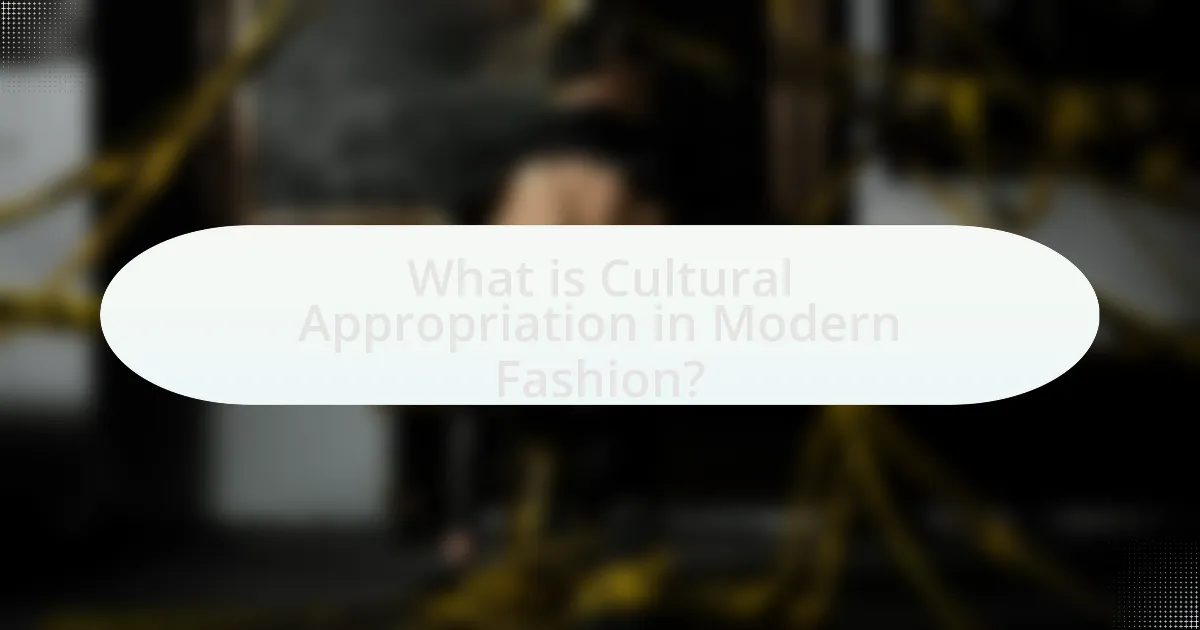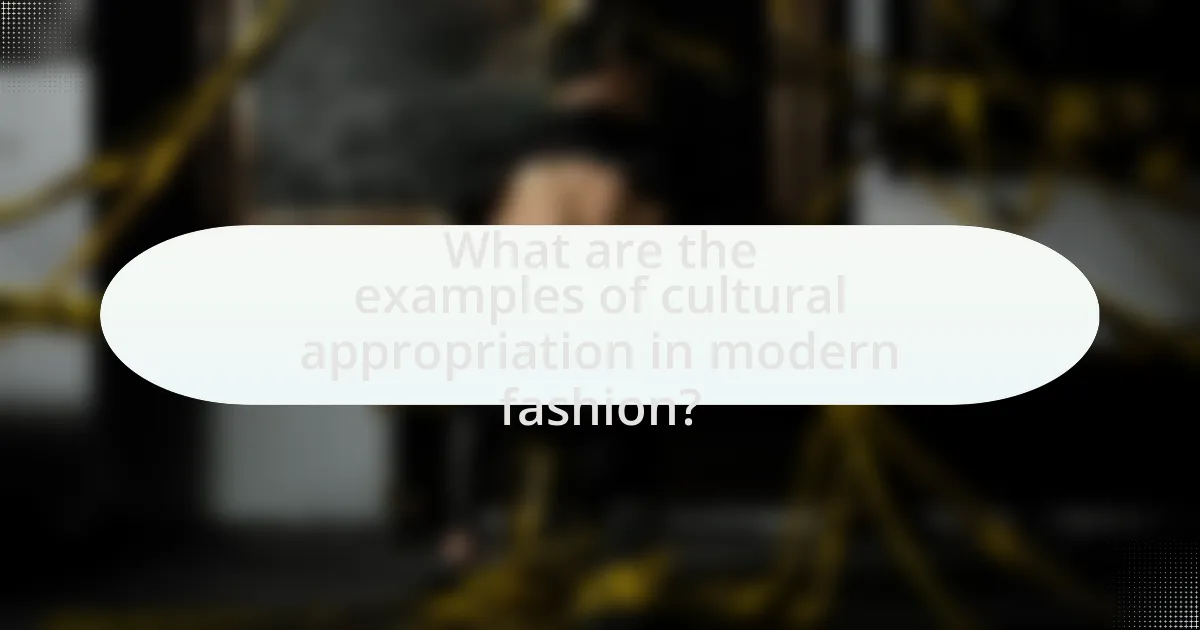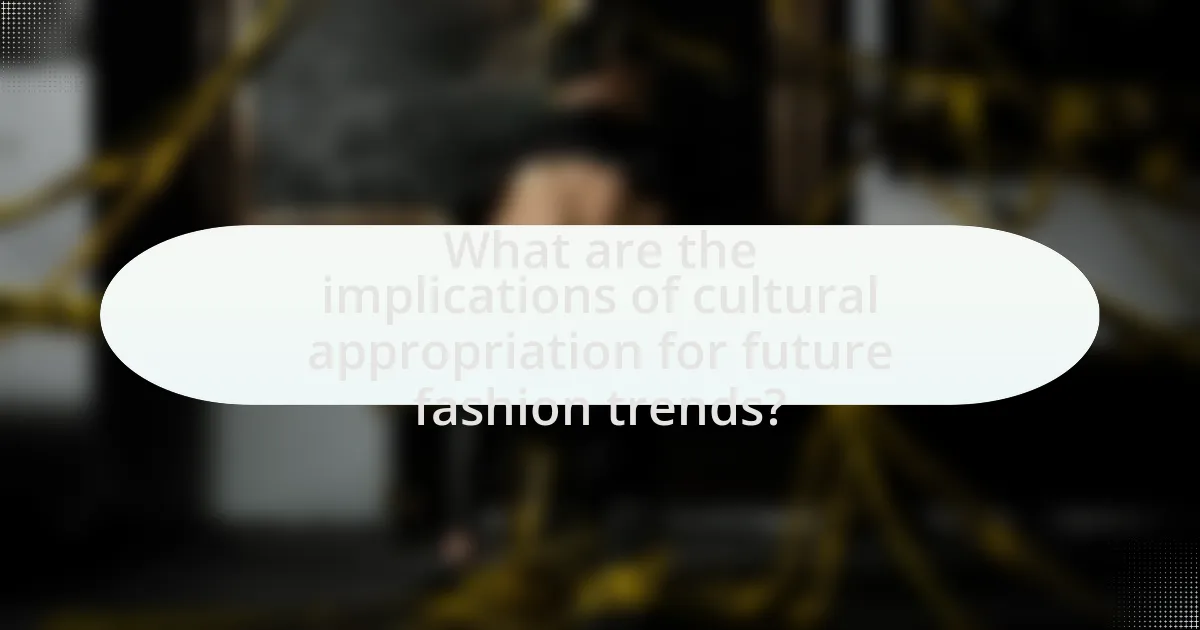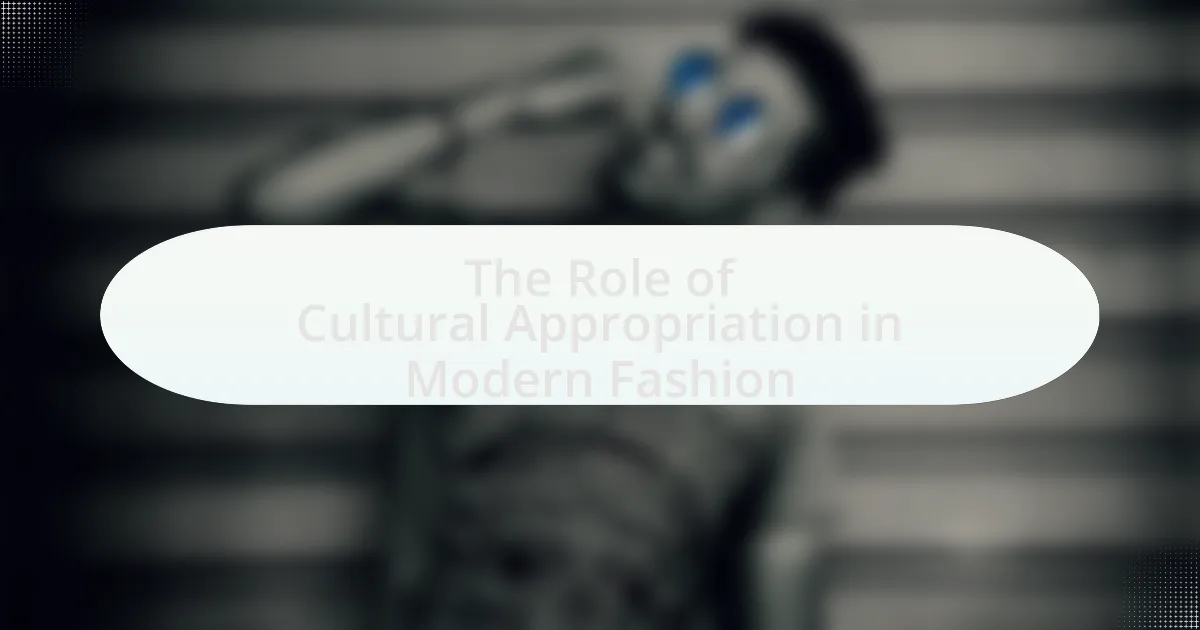Cultural appropriation in modern fashion involves the adoption of elements from one culture by another, often leading to exploitation and disrespect, particularly towards marginalized communities. This article examines the definition, historical roots, and significant issues surrounding cultural appropriation in fashion, highlighting notable examples and their impact on public perception and brand reputation. It also discusses the differences between cultural appropriation and appreciation, the implications for marginalized communities, and strategies for brands to engage respectfully with cultural elements. Furthermore, the article emphasizes the importance of education, collaboration, and ethical practices in fostering a more inclusive and respectful fashion industry.

What is Cultural Appropriation in Modern Fashion?
Cultural appropriation in modern fashion refers to the adoption of elements from one culture by members of another culture, often without permission or understanding, leading to issues of exploitation and disrespect. This phenomenon is particularly evident when fashion designers and brands incorporate traditional clothing, symbols, or styles from marginalized cultures into their collections, frequently for commercial gain. For instance, the use of Native American headdresses in fashion shows has sparked significant controversy, as these items hold deep cultural significance and are not merely aesthetic choices. The lack of acknowledgment or compensation to the originating cultures further exacerbates the problem, highlighting the power dynamics at play in the fashion industry.
How is cultural appropriation defined in the context of fashion?
Cultural appropriation in the context of fashion is defined as the adoption of elements from one culture by members of another culture, often without permission or understanding of the original cultural significance. This practice can lead to the commodification of cultural symbols, where traditional attire or motifs are used in fashion without acknowledgment of their origins, potentially reinforcing stereotypes and causing harm to the source culture. For instance, the use of Native American headdresses in fashion shows has sparked controversy, as these items hold deep spiritual significance and are not merely decorative.
What are the historical roots of cultural appropriation in fashion?
Cultural appropriation in fashion has historical roots that trace back to colonialism and the globalization of trade. During the colonial era, Western powers often appropriated indigenous clothing and textiles, reinterpreting them without acknowledgment of their origins. For instance, the British Empire’s expansion led to the adoption of Indian textiles, such as paisley patterns, which were then commercialized in Europe. This practice continued into the 20th century, where designers like Yves Saint Laurent drew inspiration from diverse cultures, often without crediting the original sources. The lack of recognition and respect for the cultural significance of these garments highlights the ongoing issues of power dynamics and exploitation in fashion history.
How does cultural appropriation differ from cultural appreciation?
Cultural appropriation differs from cultural appreciation in that appropriation involves taking elements from a culture without permission or understanding, often leading to exploitation, while appreciation involves a respectful acknowledgment and celebration of another culture’s practices and traditions. For instance, cultural appropriation can be seen in fashion when designers use traditional garments or symbols from marginalized cultures without credit or context, which can perpetuate stereotypes and commodify those cultures. In contrast, cultural appreciation would involve collaborating with members of that culture, ensuring that their contributions are recognized and valued, thus fostering mutual respect and understanding.
Why is cultural appropriation a significant issue in modern fashion?
Cultural appropriation is a significant issue in modern fashion because it involves the unauthorized use of elements from one culture by members of another, often leading to exploitation and misrepresentation. This practice can perpetuate stereotypes and diminish the cultural significance of traditional attire, as seen in instances where designers use indigenous patterns or symbols without understanding their meanings. For example, the backlash against brands like Victoria’s Secret for using Native American headdresses in fashion shows highlights the disrespect towards the cultural heritage of marginalized communities. Such actions can result in economic harm to those cultures, as they are often not compensated for their contributions, further emphasizing the ethical implications of cultural appropriation in the fashion industry.
What impact does cultural appropriation have on marginalized communities?
Cultural appropriation negatively impacts marginalized communities by commodifying their cultural symbols and traditions without proper understanding or respect. This appropriation often leads to the erasure of the original cultural context, resulting in stereotypes and misrepresentation. For instance, when fashion brands adopt traditional garments from Indigenous cultures for profit, they disregard the significance of those items, which can perpetuate harmful narratives and diminish the cultural identity of the communities involved. Research indicates that such practices can contribute to social inequalities, as they exploit marginalized cultures while failing to provide recognition or benefit to those communities.
How does cultural appropriation affect the fashion industry as a whole?
Cultural appropriation significantly impacts the fashion industry by fostering controversy and sparking debates over ethics and authenticity. This phenomenon often leads to backlash against brands that exploit cultural symbols without understanding their significance, resulting in public relations crises and loss of consumer trust. For instance, high-profile cases, such as the backlash against Marc Jacobs for using dreadlocks on white models, illustrate how cultural appropriation can alienate target demographics and provoke social media outrage. Furthermore, the appropriation of traditional garments can undermine the economic viability of the cultures being appropriated, as it often leads to mass production of culturally significant items without benefiting the original creators. This dynamic highlights the need for greater sensitivity and collaboration in fashion, as brands that engage in respectful cultural exchange tend to foster positive relationships and enhance their reputations.

What are the examples of cultural appropriation in modern fashion?
Examples of cultural appropriation in modern fashion include the use of traditional Indigenous patterns and garments by mainstream brands without permission or acknowledgment. For instance, the appropriation of Native American headdresses in fashion shows and festivals has sparked significant controversy, as these items hold deep cultural and spiritual significance. Additionally, the use of African prints and styles, such as kente cloth, by Western designers often occurs without proper credit to their origins, leading to accusations of exploitation. These instances highlight the ongoing issues of respect and representation in the fashion industry, where cultural elements are commodified without understanding their historical context.
What are some notable instances of cultural appropriation in fashion brands?
Notable instances of cultural appropriation in fashion brands include the 2016 incident involving Marc Jacobs, who faced backlash for using models with dreadlocks in a runway show, which many viewed as appropriating Black culture. Another example is the 2017 controversy surrounding H&M, which released a sweatshirt featuring a child wearing a crown with the phrase “Coolest Monkey in the Jungle,” which was criticized for its racially insensitive implications. Additionally, in 2019, Gucci was criticized for a sweater that resembled blackface, prompting widespread outrage and calls for accountability. These instances highlight the ongoing issues of cultural sensitivity and appropriation within the fashion industry.
How did these instances affect public perception of the brands involved?
Instances of cultural appropriation in modern fashion have significantly damaged public perception of the brands involved. For example, brands like Gucci and Prada faced backlash for using culturally insensitive imagery, leading to accusations of racism and insensitivity. This resulted in a decline in consumer trust and loyalty, as many customers began to view these brands as out of touch with cultural sensitivities. According to a 2019 survey by the American Marketing Association, 62% of consumers stated they would avoid brands that they perceive as culturally insensitive. This data underscores the tangible impact of cultural appropriation controversies on brand reputation and consumer behavior.
What lessons can be learned from these examples?
Lessons learned from examples of cultural appropriation in modern fashion include the importance of cultural sensitivity and the need for respectful engagement with diverse cultures. These lessons highlight that appropriation can lead to misunderstandings and reinforce stereotypes, as seen in instances where designers have faced backlash for using traditional garments without understanding their significance. Additionally, the examples demonstrate that collaboration with cultural representatives can foster authenticity and appreciation, rather than exploitation, thereby promoting a more inclusive fashion industry.
How do designers and brands respond to accusations of cultural appropriation?
Designers and brands typically respond to accusations of cultural appropriation by issuing public statements, engaging in dialogue with affected communities, and sometimes modifying their designs or marketing strategies. For instance, when Gucci faced backlash for a sweater resembling blackface, the brand apologized and committed to increasing diversity within its workforce and leadership. Additionally, some brands collaborate with cultural representatives to ensure respectful representation, as seen when Marc Jacobs worked with Native American artists to create a more authentic collection. These responses aim to address concerns, demonstrate accountability, and foster a more inclusive approach to fashion.
What strategies do brands use to address cultural appropriation concerns?
Brands address cultural appropriation concerns through strategies such as collaboration with cultural representatives, transparent sourcing practices, and community engagement initiatives. Collaborating with cultural representatives allows brands to gain authentic insights and ensure respectful representation, as seen in partnerships like Adidas with Indigenous artists for limited edition collections. Transparent sourcing practices involve clearly communicating the origins of designs and materials, which helps build trust and accountability. Community engagement initiatives, such as supporting local artisans or cultural education programs, demonstrate a commitment to honoring the cultures they draw inspiration from, thereby mitigating appropriation concerns.
How effective are these strategies in changing public opinion?
Strategies aimed at changing public opinion about cultural appropriation in modern fashion are effective, particularly when they utilize social media campaigns and educational initiatives. Research indicates that social media can amplify voices and foster discussions, leading to increased awareness and shifts in perception. For instance, a study by the Pew Research Center found that 69% of adults in the U.S. believe social media is an effective platform for raising awareness about social issues. Additionally, educational programs that highlight the historical context and impact of cultural appropriation can lead to more informed opinions, as evidenced by initiatives in universities that have successfully altered student attitudes towards cultural sensitivity.

What are the implications of cultural appropriation for future fashion trends?
Cultural appropriation will significantly shape future fashion trends by fostering a greater emphasis on authenticity and ethical sourcing. As consumers become increasingly aware of the cultural significance behind certain styles and garments, brands will face pressure to respect and honor the origins of the cultures they draw inspiration from. This shift is evidenced by the rise of movements advocating for cultural sensitivity, which have led to brands facing backlash for insensitive designs, such as the controversy surrounding the use of Native American headdresses in fashion shows. Consequently, future trends are likely to prioritize collaborations with cultural representatives and the incorporation of traditional craftsmanship, ensuring that fashion evolves in a way that honors diverse heritages while promoting inclusivity and respect.
How can the fashion industry move towards more ethical practices?
The fashion industry can move towards more ethical practices by adopting sustainable sourcing, ensuring fair labor conditions, and promoting transparency in supply chains. Sustainable sourcing involves using eco-friendly materials and reducing waste, which can significantly lower the environmental impact of fashion production. For instance, the Global Fashion Agenda reported that the fashion industry is responsible for 10% of global carbon emissions, highlighting the need for sustainable practices. Ensuring fair labor conditions includes paying fair wages and providing safe working environments, which can be supported by organizations like the Ethical Trading Initiative that sets standards for labor rights. Promoting transparency in supply chains allows consumers to make informed choices, as seen in the Fashion Transparency Index, which evaluates brands on their commitment to ethical practices.
What role does education play in preventing cultural appropriation?
Education plays a crucial role in preventing cultural appropriation by fostering awareness and understanding of cultural histories and contexts. Through education, individuals learn about the significance of cultural symbols, practices, and attire, which helps them recognize the difference between appreciation and appropriation. For instance, educational programs that include diverse cultural perspectives can highlight the historical exploitation and marginalization of certain cultures, thereby encouraging respectful engagement rather than appropriation. Studies have shown that informed individuals are more likely to engage in culturally sensitive practices, reducing instances of appropriation in areas such as fashion, where misrepresentation can perpetuate stereotypes and harm marginalized communities.
How can collaboration with cultural communities enhance fashion design?
Collaboration with cultural communities can enhance fashion design by integrating diverse cultural perspectives and traditional craftsmanship into contemporary collections. This integration allows designers to create unique, culturally rich garments that resonate with a broader audience. For instance, brands like Stella McCartney have collaborated with Indigenous artisans to incorporate traditional techniques, resulting in collections that celebrate cultural heritage while promoting sustainability. Such collaborations not only enrich the aesthetic value of fashion but also foster respect and understanding of cultural narratives, ultimately leading to more inclusive and innovative design practices.
What are some best practices for designers to avoid cultural appropriation?
Designers can avoid cultural appropriation by engaging in thorough research and understanding the cultural significance of the elements they wish to incorporate. This involves studying the history, traditions, and meanings behind cultural symbols and practices to ensure respectful representation. Collaborating with individuals from the culture being referenced is another best practice, as it allows for authentic perspectives and insights, fostering a more genuine connection. Additionally, designers should prioritize ethical sourcing and fair compensation for cultural contributions, which acknowledges the value of the culture and its creators. These practices are supported by the growing emphasis on cultural sensitivity in the fashion industry, as highlighted by initiatives like the Fashion Industry Charter for Climate Action, which encourages sustainable and respectful practices.
How can designers engage with cultural communities respectfully?
Designers can engage with cultural communities respectfully by prioritizing collaboration and open dialogue. This approach ensures that the voices and perspectives of the community are heard and valued, fostering mutual understanding. For instance, designers can involve community members in the design process, allowing them to share their cultural narratives and insights, which can lead to authentic representation. Research indicates that when brands collaborate with cultural communities, they not only enhance their creative output but also build trust and loyalty among consumers. A study by the University of Southern California highlights that brands that engage in genuine partnerships with cultural groups see a 30% increase in customer satisfaction and brand perception.
What resources are available for designers to learn about cultural sensitivity?
Designers can access various resources to learn about cultural sensitivity, including online courses, books, and workshops. For instance, platforms like Coursera and Udemy offer courses specifically focused on cultural awareness in design. Books such as “Cultural Appropriation and the Arts” by James O. Young provide in-depth analysis and case studies. Additionally, organizations like the American Institute of Graphic Arts (AIGA) host workshops and webinars that address cultural sensitivity in design practices. These resources are essential for understanding the implications of cultural appropriation and fostering respectful design approaches.

Leave a Reply